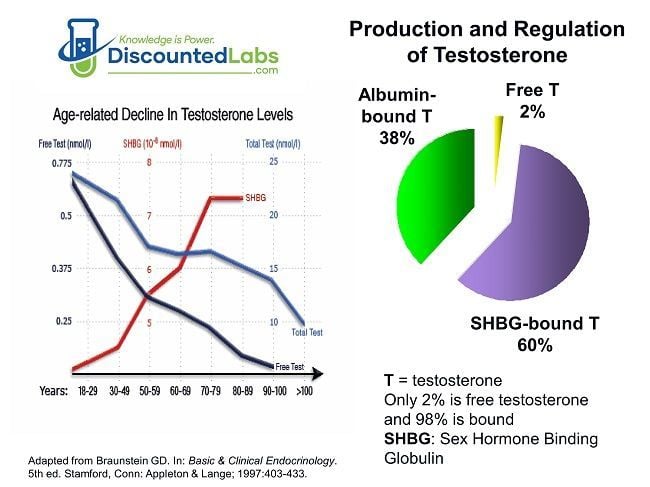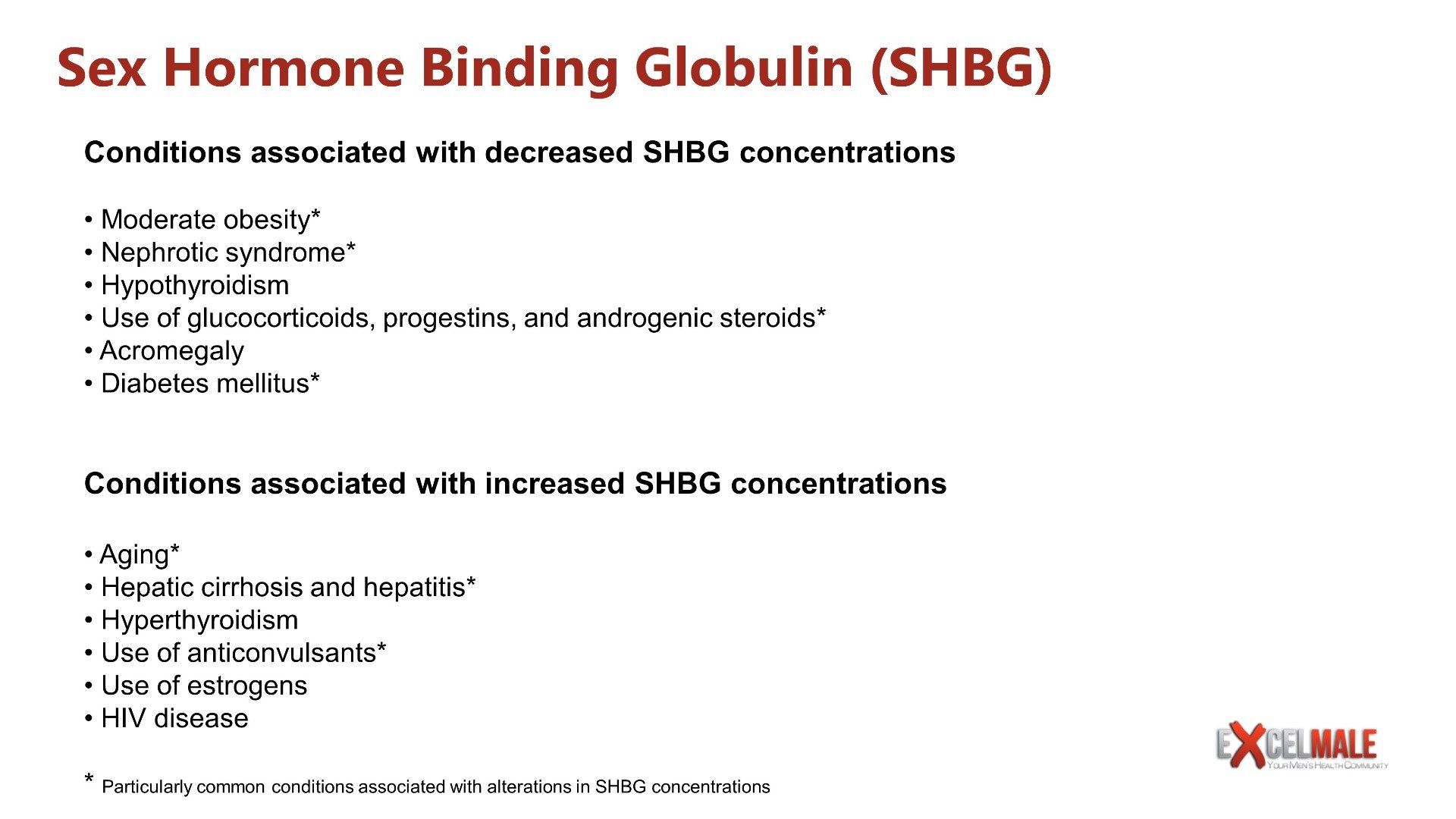SHBG and Free Testosterone - Everything You Need to Know

Table of Contents
- Testosterone Fractions in Men
- How SHBG Influences Free Testosterone
- What Factors Influence Your SHBG Levels?
- How Do You Know if Your SHBG Levels Are High?
- How to Lower SHBG and Automatically Increase Free Testosterone Levels?
- What if My SHBG Levels Are Already Low?
- Now You Know More About SHBG and the Role It Plays in Your Body!
When people hear about testosterone, they immediately think about muscles, alpha males, confidence, and probably sports cars. This is the most important male sex hormone and one of the most important hormones in the human body.
However, this hormone has several fractions. It is influenced by your lifestyle and it can influence how you think and how you feel. For example, too much sex hormone-binding globulin (SHBG) can decrease free testosterone which can lead to low libido and other symptoms. That is why some men search for ways to decrease SHBG levels.
If you are interested in testosterone fractions and how to naturally increase this sex hormone in your body then keep reading. You will find out more about the bioavailability of testosterone and why it plays a vital role in your health. You will also find out how to decrease SHBG levels.
Testosterone Fractions in Men
If you do a testosterone test, your doctor will mention your average levels. For example, the generally accepted healthy levels of testosterone for men are between 350 ng/dl and 1,100 ng/dl. If you have a total testosterone level under 350 ng/dL, you might be diagnosed with hypogonadism (testosterone deficiency).
However, this is the total testosterone level in your bloodstream. This hormone is made up of several fractions and they are important too. For example, there are bound testosterone (bound) and free testosterone (non-bound) levels that circulate through your blood. Total testosterone is made up of these two types of testosterone.
Free testosterone makes up for about 2% of your total testosterone levels. This is the one that goes to your muscles, brain, and influences other organs and tissues in your body. The bound testosterone usually attaches to two substances - albumin or SHBG.
The amount of testosterone that is bound to albumin is about a third of your total testosterone. The amount of testosterone that is bound to SHBG is approximately two-thirds of your total testosterone. Albumin is a protein and it carries your testosterone through the bloodstream and releases it as it is needed.
You often hear the term "bioavailable testosterone". This refers to the amount of testosterone that can be used by your body. Luckily, testosterone bound to albumin can detach if necessary and get used as free testosterone. The one bound to SHBG cannot do that.
In this case, the bioavailable testosterone in your body is the sum of free testosterone and albumin-bound testosterone.
How SHBG Influences Free Testosterone
It's a well-known fact that the levels of albumin in your blood are generally stable. This protein doesn't have massive spikes in quantity for a male adult. On the other hand, SHBG levels can increase and decrease based on various factors.
Most importantly, the levels of SHBG influence how much free testosterone you have in your blood. High levels of SHBG are usually associated with low levels of free testosterone. Less testosterone is available for muscles, the brain, and organs.
The vice-versa is also true. Lower levels of SHBG are associated with higher levels of free testosterone. This can positively influence your mood and libido.
What Factors Influence Your SHBG Levels?
Multiple types of factors influence how much SHBG there is in your bloodstream. Aging is one of the most important factors. As men age, their SHBG levels will naturally go up while the free testosterone levels will go down.
However, you can do something about the other factors. For example, liver problems can increase SHBG levels in men of all ages. If you have a fatty liver due to chronic alcohol consumption or other reasons, chances are that your SHBG levels are also higher than normal. This is true for other liver problems such as cirrhosis or cancer.
Thyroid problems can also increase SHBG levels. If your thyroid gland is less active or hyperactive, you might start to feel the symptoms of this health issue. Too much estradiol in your body is also responsible for increasing SHBG levels.
Obesity and high triglyceride levels are commonly associated with an increase in SHBG levels in the blood. If you are overweight and your lipid profile is not very good, chances are that your overall testosterone levels might drop.
Finally, inflammation is another factor that could increase SHBG levels and decrease free testosterone ones. Acute inflammation is good for the body to help you fight diseases. Chronic inflammation, on the other hand, can lead to life-threatening issues and raise your SHBG levels.
How Do You Know if Your SHBG Levels Are High?
A simple blood test provides the best opportunity to test your testosterone levels accurately. Medical technology got very advanced, and it's possible to find out exactly how much testosterone is flowing through your blood quickly and safely.
However, remember that most tests will communicate your total testosterone levels. You should dig a little bit deeper and find out the exact SHBG and free testosterone levels. These are the ones that interest you the most in this case. If the percent of total testosterone that is free testosterone is below 2 percent, then you may have high SHBG.
For example, the optimal SHBG levels in adult males are between 10 and 60 nmol/L. If you have more than that, chances are that your free testosterone levels are also smaller than normal. Ask your doctor for assistance if you cannot figure out the SHBG levels independently. Discounted Labs sells several tests, including the SHBG test as part of lab test panels.

How to Lower SHBG and Automatically Increase Free Testosterone Levels?
Now that you have learned more about SHBG and how it can influence your body, the next obvious question is to find out a way to decrease SHBG levels. You cannot stop the aging process, but you can do something about the other factors that influence SHBG.
Raise Your Total Testosterone Level
This is the simplest and often the best method to reduce SHBG and increase free testosterone. If your testosterone levels are low, do something to increase them. For example, you can lose weight, start exercising more often and clean your diet of junk food and processed meals.
This will automatically increase your total testosterone level. A fraction of this level is free testosterone, but it's a fraction of something larger than before, so you'll definitely experience its positive effects.
Lower Your Estradiol Levels
Another way you can reduce your SHBG levels is by lowering the number of estrogens in your body. Estrogens are the maprimaryemale sex hormones but are also needed by the male body. One of the most important estrogens is estradiol. Men have small amounts of estradiol too, but too much can lead to high SHBG levels and even gynecomastia if low testosterone is present.
Lowering estrogen levels is possible for men of all ages. For example, you should avoid soy-based products as these have the tendency to increase your blood estrogen levels. At the same time, try to minimize alcohol consumption, exercise more, lose weight if you are overweight, and get plenty of sleep.
DHEA Supplements Might Help
DHEA or dehydroepiandrosterone, is one of the most abundant steroids in the human body. It's a weak estrogen and androgen hormone. It serves many purposes in the body and it can be sold as a supplement.
Some studies show that small doses of DHEA administered to men might decrease SHBG levels. However, more research is needed as increasing the levels of DHEA in the body can have serious side effects in the long run.
For example, high levels of DHEA are commonly associated with Parkinson's Disease. This complex neurodegenerative disease can lead to memory loss and poor brain function. If you decide to take DHEA supplements, make sure that you speak with your doctor first.
Remember that these solutions might work for people with SHBG levels higher than normal. If your SHBG level is low, you should not worry about lowering it further.
What if My SHBG Levels Are Already Low?
In this case, your free testosterone levels are optimal and you don't have to do anything to increase them. However, more SHBG is needed too. This could signify an underlying health condition that must be explored further.
For example, if you have low SHBG in your bloodstream, you might have a fatty liver or metabolic syndrome. This condition can be caused by excessive alcohol consumption or other factors. A liver problem is usually associated with insulin resistance too.
Generally speaking, low SHBG levels are good predictors of diabetes in people of all ages. You must do a blood glucose and a A1c test to see how glucose is processed in your body. If you're pre-diabetic, you can still do something to increase insulin sensitivity and avoid this chronic condition.
Now You Know More About SHBG and the Role It Plays in Your Body!
Although deciphering the mysteries of testosterone and SHBG is not easy, major medical advancements are made each day. As you can see, too little SHBG is bad, but too much of it is not good either. Patients must aim for an optimal level of SHBG and monitor it closely using a SHBG blood test.





